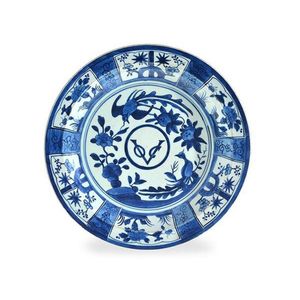Japanese Arita Charger with Dutch East India Company Monogram
You must be a subscriber, and be logged in to view price and dealer details.
Subscribe Now to view actual auction price for this item
When you subscribe, you have the option of setting the currency in which to display prices to $Au, $US, $NZ or Stg.
- East India Company - The British East India Company was a British trading company that was active from 1600 to 1858. It was one of the leading commercial enterprises of its time and played a key role in the development of British trade and commerce with India, China, and Southeast Asia.
The British East India Company was granted a monopoly on trade with the East Indies by the English government, and it quickly established a network of trading posts and settlements throughout India and Southeast Asia. The company was involved in numerous wars and conflicts in India and Southeast Asia, and it gradually gained political influence over large parts of the region.In addition to its commercial activities, the British East India Company was also involved in the spread of British culture and influence in the regions it traded with. The company played a significant role in the introduction of British goods, ideas, and institutions in India and Southeast Asia, and it was instrumental in the establishment of the British Empire in India.The British East India Company was dissolved in 1858, following the Indian Rebellion of 1857.
The Dutch East India Company, also known as the Vereenigde Oost-Indische Compagnie (VOC), was a Dutch trading company that was active from 1602 to 1798. It was one of the first multinational corporations in the world and one of the largest commercial enterprises in history.
The Dutch East India Company was established with the goal of establishing a trade monopoly in the spice trade with the East Indies. The company was granted a 21-year monopoly on the Dutch spice trade, and it quickly became one of the most successful and powerful trading companies in the world.
Over the course of the 17th and 18th centuries, the Dutch East India Company expanded its reach and influence throughout Southeast Asia, the Indian subcontinent, and the Far East. The company established a network of trading posts and colonies, and it played a major role in the commercial and political development of many regions in Asia.
Despite its commercial success, the Dutch East India Company was also notorious for its ruthless treatment of local populations and its exploitation of resources. The company was involved in numerous conflicts and wars throughout its history, and it was accused of using slave labor and engaging in acts of piracy.
The Dutch East India Company was dissolved in 1798. - Charger - A charger is a type of large plate, typically used as a decorative base for smaller plates or bowls. They are often used in formal settings, such as at a banquet or a special occasion.
The history of chargers can be traced back to medieval times, when they were used as a base for serving dishes in banquet settings. They were typically made of metal, such as silver or pewter, and were highly decorative, often featuring intricate engravings or designs.
During the Renaissance period, chargers began to be made of porcelain, and their designs became more ornate. They were often used in the homes of the wealthy and were considered a symbol of wealth and status.
In the 18th and 19th centuries, chargers were produced in great numbers by European porcelain manufacturers, and they were exported to America and other parts of the world. They were highly sought after by the upper class and were often used as a decorative element in formal table settings. - Edo Period, Japan - The Edo period in Japan lasted from 1603 to 1868. During this time, Japan was ruled by the Tokugawa shogunate, a military government led by the Tokugawa family. The Edo period is characterized by a period of relative peace, stability, and economic growth, as well as by the development of a distinctive culture and society.
During the Edo period, the capital of Japan was moved from Kyoto to Edo (modern-day Tokyo), and the country became increasingly isolated from the rest of the world. The shogunate implemented strict policies to maintain control, including the restriction of foreign trade and travel. However, despite this isolation, the Edo period saw significant cultural and artistic development, including the emergence of the ukiyo-e woodblock print tradition, the growth of Kabuki theater, and the flourishing of a vibrant merchant culture.
The Edo period ended with the Meiji Restoration of 1868, which saw the collapse of the shogunate and the restoration of imperial rule.
This item has been included into following indexes:
Visually similar items

Antique Chinese blue and white kraak charger, approx 36 cm dia

A Japanese Arita blue and white porcelain V.O.C. Plate, 17th century, circa 1680, a Museum quality underglaze dish with Voc (Vereenigde Oostindische Compagnic - Dutch East India Company) insignia surrounded by long tail phoenix (ho-ho) birds, persimmons an

A large Oriental 'Voc' Dutch East India Company charger, the replica charger decorated in the Chinese kraak style in blue on a celadon grey ground, the wide border with alternate panels of flowers and fungus and centred with the interlocking Voc logo. Heig

Chinese Ming Dynasty, Wanli period 'Kraak' porcelain charger, of circular form, with slightly scalloped edge and sloping sides, the interior decorated with panel featuring birds within pond setting, surrounded by reserves of peach sprigs and precious objec
